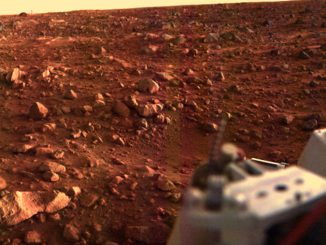
Continuing to make discoveries in the final weeks of a historic mission at Saturn, NASA’s Cassini spacecraft has recorded a unique time lapse movie looking out toward the planet’s iconic icy rings.
Cassini captured imagery to assemble the movie during an Aug. 20 swing through the gap between Saturn and its rings. Ground controllers set Cassini’s wide-angle camera to take images in a low-resolution mode — 512 x 512 pixels — to allow the spacecraft to gather more photos in a short span of time, according to NASA.
“The entirety of the main rings can be seen here, but due to the low viewing angle, the rings appear extremely foreshortened,” NASA said in a statement. “The perspective shifts from the sunlit side of the rings to the unlit side, where sunlight filters through.”
The sequence shows Cassini crossing the relatively thin ring plane as it zipped by Saturn at a speed of some 76,000 mph (122,000 kilometers per hour) relative to the planet’s cloud tops.
“On the sunlit side, the grayish C ring looks larger in the foreground because it is closer; beyond it is the bright B ring and slightly less-bright A ring, with the Cassini Division between them,” NASA said. “The F ring is also fairly easy to make out.”
Running low on fuel, Cassini is set to end its nearly 20-year mission Sept. 15 with a guided plunge into Saturn’s atmosphere. The probe will disintegrate as it descends into the deeper layers of the atmosphere, succumbing to increasing aerodynamic pressures.
Composed mostly of blocks and particles of ice, Saturn’s rings are one of the major targets for Cassini’s scientific instruments during the mission’s final months. Scientists hope to learn the mass of the rings, a figure that should yield an estimate of their age and origin.
Saturn itself is also a focus during Cassini’s grand finale.
Measurements of Saturn’s gravity and magnetic fields could help scientists study the planet’s interior structure, and Cassini’s final five passes near the planet are taking the spacecraft into the outermost reaches of the atmosphere, allowing its instruments to take direct samples.
Cassini will beam back atmospheric data in real-time during its final descent into Saturn next month until the probe’s control thrusters are unable to keep the craft’s antenna locked on Earth.
Launched from Cape Canaveral in October 1997, the spacecraft spent much of its time at Saturn making observations of the planet’s numerous moons. Cassini dropped a European Space Agency lander to Titan’s surface for a parachute-assisted landing in 2005, and found evidence that Enceladus harbors a global ocean of water buried beneath a veneer of ice.
NASA officials want to end the mission in a guided manner while the spacecraft is still healthy to avoid the chance an uncontrolled Cassini could crash into Titan or Enceladus, potentially spoiling habitats that might be prime for finding alien microbial life.
Since April, Cassini has made repeated passes between Saturn and its rings. Two more flybys are planned before the final dive Sept. 15.
Email the author.
Follow Stephen Clark on Twitter: @StephenClark1.



